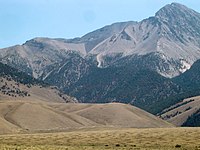
Back Frontón de falla AN حافة الصدع Arabic Geländestufe German Terena ŝtupo Esperanto Escarpe de falla Spanish پرتگاه گسل Persian Gawir sesar ID 断層崖 Japanese 단층애 Korean Tubir sesar Malay
An eroded fault scarp from the Gobi Desert of Mongolia (left) and at Borah Peak in Idaho. The latter fault scarp (white line at the base of the tan hills) was formed in the 1983 Borah Peak earthquake
A fault scarp is a small step-like offset of the ground surface in which one side of a fault has shifted vertically in relation to the other.[1][2] The topographic expression of fault scarps results from the differential erosion of rocks of contrasting resistance and the displacement of land surface by movement along the fault.[3][4] Differential movement and erosion may occur either along older inactive geologic faults, or recent active faults.[5][6][7]
- ^ Marshak, Stephen (2009). Essentials of geology (3rd ed.). New York: W.W. Norton. ISBN 978-0393932386.
- ^ "Faults" (PDF). ETH Zurich. 2020.
- ^ Easterbrook, Don J. (1999). Surface Processes and Landforms. Prentice Hall. p. 247. ISBN 978-0-13-860958-0.
- ^ Smith, Bernard J.; Whalley, W. B.; Warke, Patricia A. (1999). Uplift, Erosion and Stability: Perspectives on Long-term Landscape Development. Geological Society of London. p. 111. ISBN 978-1-86239-047-8.
- ^ Holdsworth, Robert E.; Turner, Johnathan P.; London, Geological Society of (2002). Extensional Tectonics: Regional-scale processes. Geological Society of London. p. 185. ISBN 978-1-86239-114-7.
- ^ Babar, Md (1 January 2005). Hydrogeomorphology: Fundamentals, Applications and Techniques. New India Publishing Agency. pp. 98–99. ISBN 978-81-89422-01-1.
- ^ Yorath, C. J. (2005). The geology of Southern Vancouver Island (Rev. 2005 ed.). Madeira Park, BC: Harbour Pub. ISBN 9781550173628.
© MMXXIII Rich X Search. We shall prevail. All rights reserved. Rich X Search

